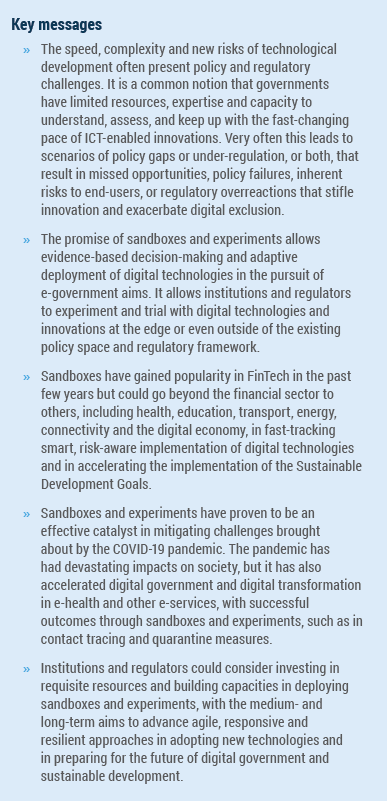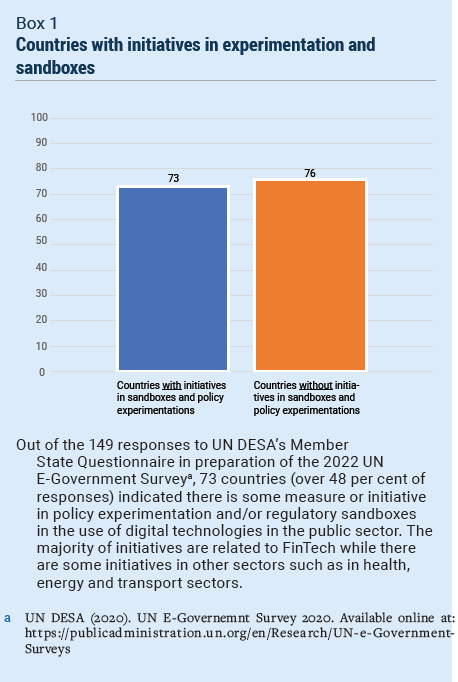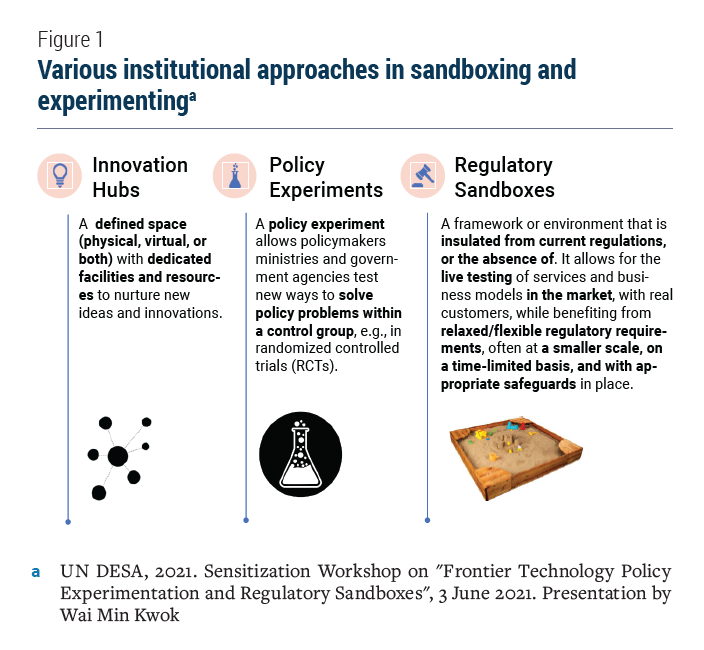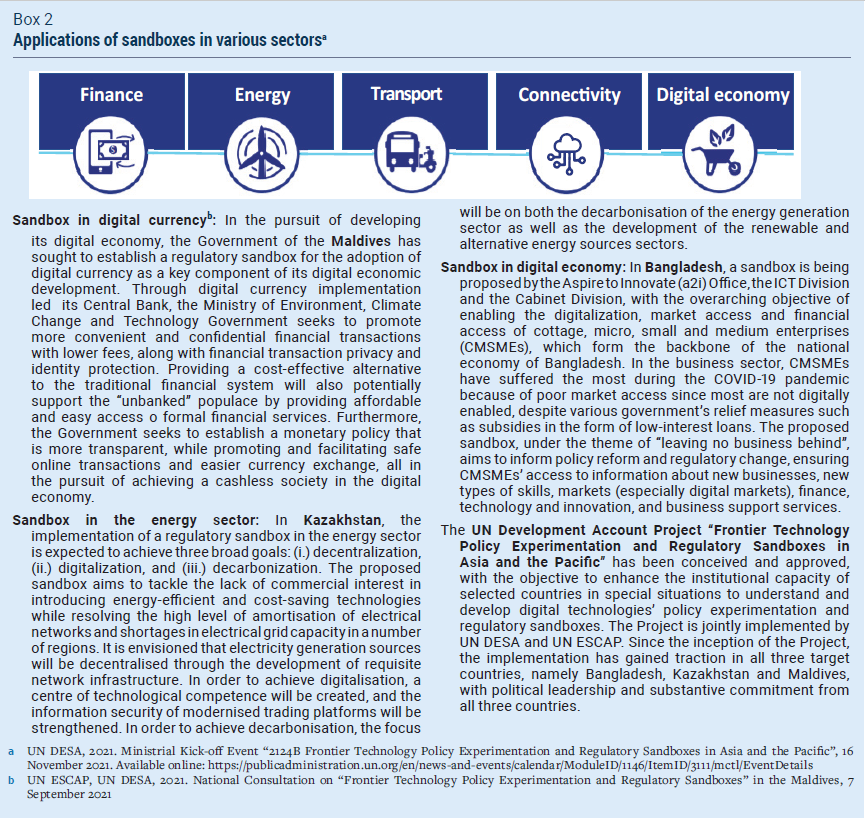
UN DESA Policy Brief No. 123: Sandboxing and experimenting digital technologies for sustainable development
 From innovation hubs and policy experiments to regulatory sandboxes
From innovation hubs and policy experiments to regulatory sandboxes
Digital technologies carry a promise to fast track sustainable development by supporting innovative, forwarding-looking policies and digital government solutions. There are, however, numerous risks and complexities of frontier technologies that come along with those opportunities, as well as policy and regulatory challenges such as those related to inclusion, competition, privacy and security.
Innovation hubs, incubators, accelerators or testbeds have since emerged as springboards for new technologies and are now common in many developed and developing countries. In some scenarios, however, the perceived risks and costs of failure in public sector innovation mean that policymakers and regulators may still prefer to stick to the status quo.
In more recent years, the relatively new approaches of sandboxes and experiments have emerged among some countries and have proven to be effective in creating a more conducive and contained space where Governments, in partnerships with the private sector and other relevant stakeholders, are able to test technologies in a controlled space with a small sample group before launching them at scale, allowing one to dramatically reduce costs and limit the chances of failure and negative impacts. Figure 1 illustrates various institutional approaches in innovation, experimenting and sandboxing.
Some countries have since implemented an institutional, policy or regulatory framework for the use of sandboxes, through public-private partnerships (PPP) or multi-stakeholder partnerships (MSP). For example, the United Kingdom’s Financial Conduct Authority (FCA) has established a regulatory sandbox for enabling more efficient small medium enterprises (SME) lending and supporting the development of digital ID in the financial sector, specifically aiming at consumers and SMEs. In Singapore, the Energy Market Authority (EMA) implemented a regulatory sandbox for the energy sector, with the primary focus on innovation in the sectors of electricity and gas, aiming to find innovative solutions for future renewable energy sources. In Kazakhstan, the Government is in the process of introducing a legislative framework through a draft bill for the use of experiments and sandboxes, referred to as an “experimental regime”, to further promote innovation and digitalization, under the joint collaboration between the Artificial Intelligence Fund (AI Fund) and the Ministry of Digital Development, Innovation and Aerospace Industry.
This policy brief benefits from a study of over 60 cases of policy experiments and regulatory sandboxes from different countries across different regions – from both developed and developing countries, with the aim to seek analytical findings on the benefits as well as challenges and risks in experimenting and sandboxing for sustainable development.
What is a sandbox?
A sandbox is a framework or environment that allows for the live testing of technologies, services and business models in the market with real consumers, while benefiting from relaxed or flexible regulatory requirements, often at a smaller scale and on a time-limited basis, and with appropriate supervision and safeguards in place. Because of the availability of a conducive and contained space through a more lenient or flexible regulatory environment, a sandbox can facilitate the pertinent deployment of digital technologies and their rapid and effective inclusion in digital government. A sandbox not only insulates innovations from current regulations which may be restrictive or non-existent, but it also insulates against possible negative impacts on end-users.
 A sandbox has the potential to meet several objectives, including both regulatory and institutional. While regulatory objectives are most commonly limited to security, inclusion, consumer protection, competition, sustainability and among others, institutional objectives may be wider in scope, such as supporting the digital government ecosystem or encouraging collaboration with the private sector and other stakeholders. Sandboxes, however, are not universally designed for all challenges confronting regulatory and policy-making bodies faced with challenges in disruptive innovations.
A sandbox has the potential to meet several objectives, including both regulatory and institutional. While regulatory objectives are most commonly limited to security, inclusion, consumer protection, competition, sustainability and among others, institutional objectives may be wider in scope, such as supporting the digital government ecosystem or encouraging collaboration with the private sector and other stakeholders. Sandboxes, however, are not universally designed for all challenges confronting regulatory and policy-making bodies faced with challenges in disruptive innovations.
Historically, sandboxes have been limited to a few fields like financial technology (Fintech). The first regulatory sandbox was launched in 2015 by the Financial Conduct Authority of the United Kingdom, when it first engaged with a wide range of firms and industry bodies to assess the feasibility of a regulator sandbox to drive innovative competition in financial services. This had in turn generated great interest from regulators and innovators in FinTech. The global development of regulatory sandboxes in Fintech has also accelerated demand for regulatory innovations in other digital services, including in health, energy and transport, disrupting the traditional use of sandboxes in the financial sector and opening the concept to other needs. Several countries have developed specific sandboxes in other sectoral areas such as in energy, transport, connectivity and the digital economy. Figure 2 shows the sectors that Bangladesh, Kazakhstan and Maldives are piloting sandboxes in as part of the United Nations Development Account Project on policy experimentation and regulatory sandboxes, jointly implemented by the UN Department of Economic and Social Affairs and the UN Economic and Social Commission for Asia and the Pacific.
Building blocks and stages of a sandbox
If implemented effectively, a sandbox can bring down the cost of innovation and reduce entry barriers, and allow policymakers and regulators to gain important insights before any decision-making. When considering a sandbox, Governments should clearly define the objectives and the challenges that need to be addressed.
The success of a sandbox relies on the capacities of institutions and the existence of relevant legislation within jurisdictions, allowing for the proper establishment of the sandbox environment. Sufficient resources should be made available to support its implementation and evaluation. Sandboxes and experiments are resource intensive, and policymakers and regulators should be aware of this prior to initiating one. Moreover, institutions may find that sandboxes and experiments demand more of their time and skill than they have anticipated. Lack of technical staff and capacity thus may lead to serious consumer protection risks as well as reputational risks for the institutions, who may be held responsible for undue consequences.
A sandbox functions as a journey or cycle and traverses through four building blocks and stages (1) conceptualization of the sandbox, including its eligibility criteria, safeguards and application requirements, organizational structure, and operational details; (2) sandbox operation after due diligence is performed; safeguards to be implemented and reporting requirements and protocols to be followed; sandboxes vary considerably in the testing durations used, from two weeks to three years; (3) evaluation of outcomes; outcomes may also result in request for an extension period or scaling up to include a wider test sample; and (4) exit of sandbox, resulting in either the deployment or discontinuation of an initiative. The deployment may be a full-fledged or tailored authorization of the innovation and necessary changes in regulation. See Figure 2 on the building blocks and flow of a sandbox.
It is important to note that each step must be completed within a defined timeframe. Conditions for each step, however, may vary depending on their design and aims by competent authorities or regulators. To ensure the proper and effective conduction of the regulatory journey, the process through these steps requires a controlled environment with clear boundaries and safeguards. Sandboxes also require institutional support and discretionary supervision throughout the cycle, further implying lenience or supervisory discretion about the way in which the policy or regulatory framework applies to innovative products or services.
Furthermore, precise considerations should be made in formulating and implementing sandboxes and experiments, particularly in countries observing significant disparities in their socio-economic contexts. Institutions should conduct feasibility assessments to gauge the scope of the policy implications and legislative frameworks, as well as the economic, social and sustainability of the sandbox, and finally the capacity to implement and operate a sandbox itself. It is also important to check viability based on external criteria or influences, for instance market demand, people’s needs and the current digital ecosystem. Institutions governing sandboxes must ensure that participating consumers are not unduly exposed to risks. Consumer protection measures within sandbox frameworks include the need to provide transparent information to consumers on data protection and other governance issues, and clarity on the respective roles of stakeholders.
Why are sandboxes and experiments relevant to the sustainable development goals?
Digitalization and technological advances have pushed development to a whole new level, bringing innovative, forward-looking solutions with enormous potential to fast forward the achievement of the 2030 Agenda for Sustainable Development, across all 17 goals and several global targets. The rise of digital technologies, however, as they scale up to be increasingly sophisticated and more pervasive, also presents new risks and amplifies threats to governments and users, such as data breaches, digital frauds, privacy and cybersecurity risks. The advent of frontier technologies such as artificial intelligence, blockchains, 5G, cloud-computing, machine learning, the Internet of Things and robotics, can also leave those unconnected and less digitally literate people further behind, widening existing divides among people digitally, economically and socially. The effective introduction of sandboxes and experiments can address policy or regulatory gaps, while striking a balance between policy and regulation constraints and the promotion of technology-driven innovations, in order to achieve optimal contributions to sustainable development, while containing risks of new technologies to the minimum.
Limitations of sandboxing and experimenting
Sandboxing and experimenting can enable Governments to engage in efficient, targeted and creative solutions and technologies in priority areas for sustainable development and in post-COVID recovery. They are, however, subject to variWous limitations.
Contextualisation matters
Generally, sandboxes provide a case-by-case rather than a one-fits-all approach. As sandboxes facilitate coordination and adaptation between technologies, policies and regulations, successful experiments may result in specific policy reforms or regulation adjustments. It must be stressed, however, that policy experiments and regulatory sandboxes should be considered as tools for flexibility and responsiveness to the needs of particular socio-economic situations. While there is no universal blueprint or set of best practices to follow, institutions regulators can consult publicly available resources before implementing a sandbox.
Limited transparency
While details about sandbox participation agreements are generally not made public and often subject to confidentiality agreements, care should be taken to avoid exclusion of segments of industries or the population, especially vulnerable groups, or causing negative public perception such as privacy and other data governance issues. In concluding a successful sandbox implementation, due consideration must be taken for existing partners of the sandbox who may enjoy significant benefits over others from special status through accommodation of relaxation of regulations and communication with the competent institution or regulator.
A sandbox is not a panacea for all digitalization challenges
A sandbox is not a panacea in addressing the potential or risks of all digitalization challenges, nor is it the only solution. Other options include agile regulatory and adaptive approaches to test new innovations under specific circumstances. Nonetheless, compared to other approaches, sandboxes are deemed to be more structured and objective-driven, but also more bureaucratic and resource-intensive.
 What can governments do to start experimenting and sandboxing?
What can governments do to start experimenting and sandboxing?
Build an institutional culture and institutional capacity of experimenting and agile government
The capacity to operate sandboxes and experiments effectively may in turn strengthen the digital capacity of institutions and regulators. Building an institutional culture in sandboxing and experimenting may also result in facilitating more open and active dialogues with innovators, increasing agility and responsiveness through digital government. Sandboxes and experiments can help break down policy and regulatory barriers to bringing in digital technologies for development. Institutions and regulators should build capacities in order to be able to give thoughtful consideration to whether innovations should be tested in a sandbox or experiment.
Inclusion and leaving no one behind
Sandboxes and experiments may open space for inclusion through digital technologies - for example, the use of digital ID, biometric ID, blockchain-based land registrations, and new business models serving marginalized clients. But they may also result in exclusion if not created with inclusiveness by design at the onset. It is important to plan deliberately for inclusion in roll-out with positive outcomes of the sandbox, with appropriate adjustments made to both the innovative concepts and technologies evaluated, and the policy and regulatory frameworks to be adjusted for all beneficiaries, beyond the sandbox target group.
Data governance in managing and evaluating sandbox operation
For successful implementation of sandboxes and experiments, data are key in the life cycle of the sandbox, including its conceptualization, operation, evaluation and exit. Timely, reliable, quality and disaggregated data, and appropriate data governance measures, are needed to facilitate the operation and evaluation of a sandbox. Data and its governance are especially important since the sandbox approach is relatively new. The utility of sandboxes and their impact on sustainable development can be further examined and substantiated through practical implementation or academic research.
Collaborative approaches, partnerships and knowledge transfer
In pursuing sandboxes and experiments, institutions and regulators will need to come together as a whole-of-government - across sectors and levels of government, and as a whole-of society – in collaboration with the private sector, think tanks, the academia and other stakeholders. While there is no universal blueprint or set of best practices to follow, institutions can consult global and regional bodies and other publicly available resources. It is also important to engage industry and other stakeholders early in the process to get diverse perspectives and to secure buy-in from various concerned partners and stakeholders. These include other jurisdictions with a sandbox in place, international development organizations such as UN DESA, other institutions through peer learning platforms or think tanks.
Experimenting and sandboxing in post-covid-19 recovery
The COVID-19 pandemic has caused widespread sufferings across all facets of our society and upended the daily lives of people, especially vulnerable groups. The pandemic has not only brought about unprecedented challenges to sustainable development, but has also accelerated digital government and digital transformation in many areas. While many governments and businesses have rapidly turned to digital platforms and digital solutions, the COVID-19 pandemic has exposed harsh fragilities and digital divides, especially for countries in special situations. Because of such digital divides, the adverse impacts of the pandemic have unevenly affected countries in special situations.
The use of digital technologies in managing challenges brought about by the pandemic across countries, such as in tracking and tracing cases or in delivering healthcare, has been promising. The emergency authorization and use of contact tracing apps, for instance - while not technically termed or referred to as a regulatory sandbox - is essentially a sandbox, as it operates in exactly the same way by allowing for the experimentation of a new technology and the collection of resulting data, facilitating communication between innovators and regulators to craft individual approvals, and allowing real-world deployment after successful, rapid pilots.
In striving to recover better post-COVID-19, we must refocus on the most pressing development issues. A number of sectoral and policy issues that are highlighted as critical in the Decade of Action and Delivery of the Sustainable Development Goals have retrogressed to different extents due to the pandemic. Such issues include climate change, global hunger, renewable energy, digital identity and social protection. Lessons learned through rapid experiments and sandboxes during the pandemic could be invaluable – in doing more with less through technology and innovation, and to have an accelerated path in addressing questions by policymakers on how to incentivise and stimulate the use of digital technologies for sustainable development.
In essence, the pandemic has fomented a force that has accelerated progress in many policy areas, including through sandboxes and experiments. The challenge remains to pick up the momentum, and to create a similar sense of urgency to leverage on digital technologies to resolve critical issues key to sustainable development for all.




Follow Us